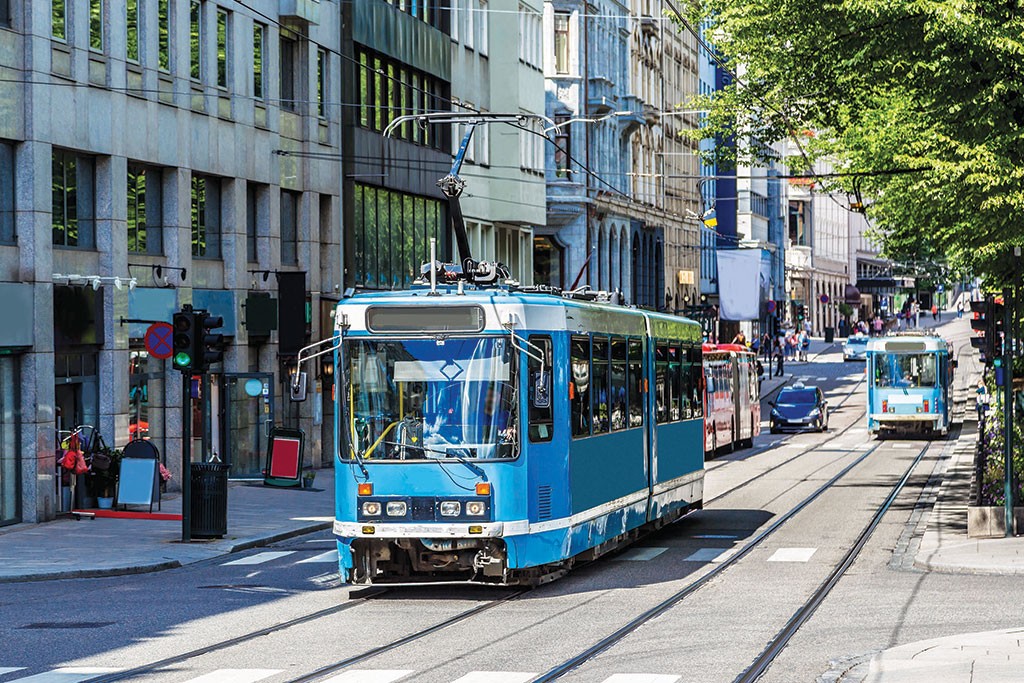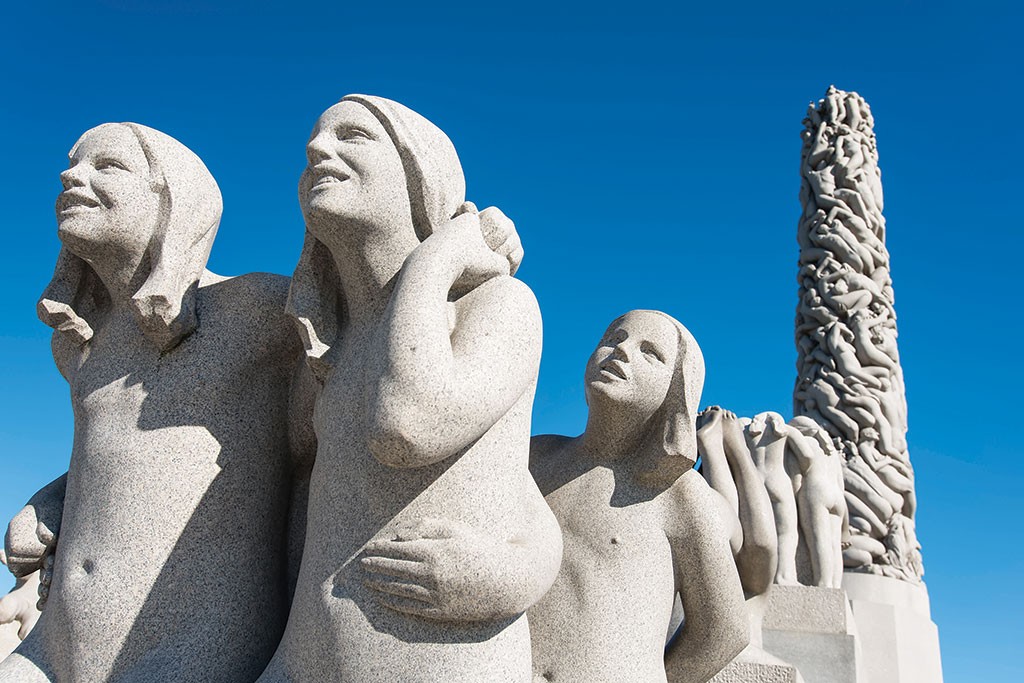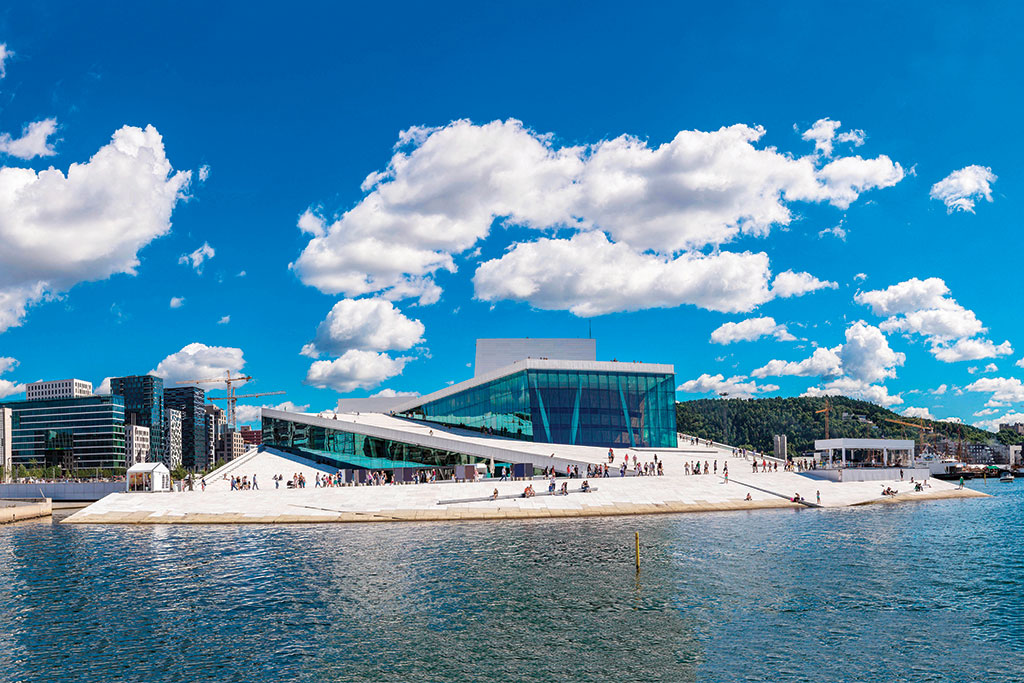I ask one of the women behind the counter about the area’s Sunday Market, and she says, taking me over to the window, “Go down that hill and look for a lot of graffiti.” Sure enough, I’m soon strolling along the Akerselva as tiny streets twist off to my left, and the river flows to the right. Despite the trees overhanging the little river, there’s a feeling that’s very urban about it, a vibe that increases as I see the anticipated graffiti and know I’ve arrived. The graffiti marks the sidewall of the Blå, an arts center with a variety of alternative programming, primarily music. Today, though, it’s devoted to the Sunday Market where a variety of vendors sell knitwear, woodwork (beautifully wrought tablet stands bring the art into the 21st century), jewelry, and handmade soaps.
I head back toward the square where I started, just a five-minute walk away, and start exploring Grüneløkka. I look into Robot, with its great selection of vintage clothing, and Chillout Travel Centre, with travel supplies and a little café in the back. Walls along the street are covered with posters for concerts and other events. I admire the jewelry, ceramics, and glasswork in Kunsthånverkere (handmade art), am tempted by the olive oil selection in Oliviers, want to buy gifts for all my friends (and maybe even for myself) in four little boutiques right next to each other called Detaljer, Rebella, Insomnia, and Boa. In this part of town, the mannequins in the Salvation Army window have purple and blue wigs. Any more questions?

I definitely check out Bar Boca, a sweet little coffee place (they also serve alcohol) that becomes more of a bar in the evening. I love its retro look: kidney-shaped orange tables, aqua walls with little squiggles on them, black-and-white tile behind the bar, and brass sconces in the shape of wavy flower stems. Right here at the front is my favorite of the three little rooms. The others have the same laid- back, comfy feel, but this one has that 1950’s styling I love. The guy behind the counter is nice as can be, the music is soft, and the espresso and croissant hit the spot.
Back out on the street, I realize that this is where I’d want to live if I moved to Oslo. It’s not as pretty-pretty as some of the city, but it feels like a real place, where real people live, and it has a bit of an edge that keeps it interesting. It’s also extremely gay-friendly, so that even though none of the “official” gay bars are in the neighborhood, Oslo friends tell me a gay couple could easily fit in at any of the Grüneløk- ka night spots. So do check it out. It will be a day well-spent, and almost entirely free of touristy things. Take your time and soak it all in. Life is good on the “wrong” side of the river sometimes, and you’ll come away from it appreciating Oslo even more.
Did I say Oslo is acquiring a patina of chic? There’s no better example than the opening of the luxury design hotel The Thief, across the city from Grüneløkka in the district of Tjuvholmen, once a refuge for criminals and other shady types (hence the name). It’s next to the better-known Aker Brygge, a bustling collection of restaurants and shops developed from an almost-deserted harbor area. The Thief is a hotel like Oslo has never seen: modern, deluxe, and design-conscious, with enough art scattered around the building to open a contemporary art museum (which is exactly what happened next door at the fabulous Renzo Piano-designed Astrup Fearnley Museum, of which the hotel is a sponsor and gets loans for display). Richard Price’s “The Horse Thief” lights up the lobby. Video art by Julian Opie makes your elevator rides a pleasure. An Andy Warhol original sits insouciantly on a wall of the restaurant.
My room is all tones of Norwegian nature, with a huge assortment of pillows on the bed, a zig-zagging old bas relief framed in light, large mirrors, and balconies with astounding views of the harbor. It’s a game-changer in Oslo, a luxury hotel that’s more about modern chic than old-school type grandeur and quite a celebrity haven, “we treat our guests like rock stars and our rock stars like guests,” they like to say.
Then there’s the food. Even if you’re not staying here, you do have to experience Fru K (named after the woman who by legend ruled the island back in the day). The space has a lounge-y feel that belies the amazing food you’re about to have. Beet tartare comes in a little disc topped with a quail egg and Parmesan cheese. Monkfish sits next to a drizzle of smoked hollandaise, with tiny pickled cucumber and celeriac purée. Dessert might be sour milk sorbet with raisin jam, fresh thyme, and crumbled cookies. It’s all immaculately presented, looking as pretty as it tastes. I’m seeing a Michelin star or two in the near future.
The next day, I walk up to City Hall and the minute I arrive, a #30 bus is heading out to Bygdøy, so I hop on and go to the amazing Norwegian Folk Museum, a collection of buildings from all over Norway. There are interesting exhibits here on the life of the Sami (Norway’s indigenous people) and Norwegian folk and church art, but it’s the outdoor arrangements I love. I admire the 13th-century Stave Church, which looks like a Viking fantasia with its ship-like protrusions, the 14th-century storehouse made of logs, and the recreated “old town.” Like always, I plan on about 20 minutes and end up spending two hours wandering through the centuries of architecture.

There is a wealth of museum exploration on Bygdøy, from the Kon-Tiki Museum, devoted, of course, to adventurer/explorer Thor Heyerdahl, to the Viking Ship Museum, with its ninth-century craft and variety of tools, household goods, and small boats. I love the Fram Museum, where you can walk around on the eponymous boat that’s sailed the Arctic to Antarctica, and even feel the conditions in the “polar simulator.” Does it sound like a full day? Well, there couldn’t be a lovelier spot to wander museum to museum, and experience a little natural beauty at the same time.
Outside the folk museum, the bus pulls up minutes after I get to the stop. I take it straight to the Opera House, another marvel of modern Oslo. It’s apparently the beginning of another harbor area that, like Aker Brygge, is due for redevelopment. The Opera House is a beauty, looking like a modernistic (or futuristic) ship, all white on white. Even if you don’t see an opera here, be sure to take a look inside at the gleaming interior filled with art, and by all means hike up to the roof for a spectacular view out over the city and water. You’ll see church spires and classical buildings, but you’ll also see the modern skyscrapers like those across from the Opera House whose nickname (you’ll see why) is “the bar code buildings.” The Opera House, an exciting representative of an Oslo that’s joined the modern age, is as stunningly contemporary as any performance space I’ve seen.
From here, I walk over to the train station, three minutes away, where I catch my favorite #19 tram to Ekeberg Sculpture Park, which opened in 2013 in the southeast of the city. Unlike Vigeland Park, devoted to the work of a single man, this park features a variety of artists scattered across a hillside with panoramic views of the city and water. At the center of it all is Ekeberg Restaurant, where the spectacular views and solicitous service make me worry in my cynical way that the food will be less than top-notch. Guess what: from the elegant fish soup I start with to the mango/white chocolate cake that ends my meal in sweet pleasure, it’s great.
Back at The Thief, I prepare to leave Oslo, excited by the changes that have happened and the promise of more to come. About 80% of the hotels and restaurants I’ve mentioned have opened within the last ten years, transforming the city from pleasant-but-slight yawn into a dynamic metropolis in the making that’s up there with the best of them. I end my night, and my trip, on my balcony at The Thief, looking out at the lights of Aker Brygge, the boats silhouetted against the glow of the city beyond. I watch the clouds move across the nighttime sky and the waves bringing shimmers of reflected light from bridge to bridge.
Ten years ago, you didn’t see hotels like The Thief or Saga, or restaurants like I’ve discovered this time, but the pleasures Oslo has always offered are still here. There are just new ones now as well, and nothing pleases me more than to see this city I’ve always liked acquiring a bit of an edge, a bit of cosmopolitan appeal. There’s so much to discover here, so much to admire as it unfolds.
You May Also Enjoy:
Exploring Svalbard: Norway’s High Arctic


